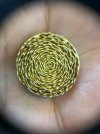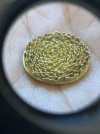purplepepper8
Member
Hi,
I made a piece in 18KY gold and the piece has got a greenish colour to it. I think it is caused by leaving it in the pickle (I use a citric acid pickle). From my understanding, it is caused by the copper leaching out of the surface of the metal into the solution. If I polish the surface, the original, redder colour is restored to the surface. However, as you can see from the photos, the issue with this piece is it is that it has lots of grooves and small openings where it is hard to polish.
Does anyone know how I can deal with this issue and how I can avoid it in the future?
Thanks
Aman
I made a piece in 18KY gold and the piece has got a greenish colour to it. I think it is caused by leaving it in the pickle (I use a citric acid pickle). From my understanding, it is caused by the copper leaching out of the surface of the metal into the solution. If I polish the surface, the original, redder colour is restored to the surface. However, as you can see from the photos, the issue with this piece is it is that it has lots of grooves and small openings where it is hard to polish.
Does anyone know how I can deal with this issue and how I can avoid it in the future?
Thanks
Aman








